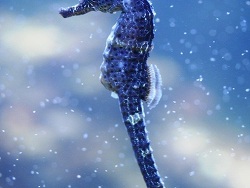Info
Hippocampus borboniensis, also known as the Réunion seahorse, is listed in Appendix II of CITES. In nature, it is known from the islands of Reunion, Madagascar, Mauritius and Zanzibar. The animals in the photos, however, we found on the coast of Tanzania, north of the town of Tanga and Pemba Island (Zanzibar).
There is little available data on the further spread of the hippocampus borboniensis or even accurate figures on the population or their exact habitat. The place of discovery in one case was a seagrass meadow nearby the beach (about 150 - 200 meters from the beach). The seaweed was affected to a large extent by sediments and the seahorses were found in small groups of three to four animals in small hollows in the protection of sea grasses.
Borboniensis hippocampus is very similar to H. Kuda and is nearly as large (14 -15 cm). H. kuda has a deeper head; a coronet that is curled backwards and rounded; cheek spines are more prominent and other spines less developed. It is dusty green-brown with dusty yellow dots and marbling and broken lines on head; or dark and uniform. Like all seahorses the Reunion seahorses feed on plankton, so small crustacean.
Order: Gasterosteiformes
Family: Syngnathidae
Genus: Hippocampus
Species: Hippocampus borboniensis
hma
Feeding intake.
The fish take a long time to eat at the beginning, before the food is taken up, a close inspection is carried out. After acclimatisation, the offered frozen food is eaten without problems. It should be noted that wild-caught fish behave differently than offspring when it comes to food intake. In the case of offspring, the size of the fish purchased also plays a role in the choice of food.
You can download the minimum requirements for keeping seahorses (in accordance with EC Regulation 338/97) from the Federal Agency for Nature Conservation as a PDF here: https://meerwasser-lexikon.de/downloads/BfN_Mindestanforderung_haltung_seepferdchen_hippocampus.pdf







 Kathrin Merkel, Deutschland
Kathrin Merkel, Deutschland



























































